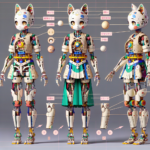
Measuring Up: The Anime Figure Conversion Guide
Hey there, fellow anime aficionado! If you’ve ever found yourself puzzled over how to convert the size of your favorite anime figures from inches to centimeters, you’re in the right spot. Whether you’re double-checking a figure’s size to make sure it fits perfectly on your shelf, or you’re trying to understand the scale of a new release, getting these measurements right is key to a satisfying collection. No need to scratch your head any longer; I’ve got you covered with a simple guide that’ll make conversions a breeze.
Key Takeaways
- Understand the importance of accurate measurements for anime figures.
- Learn the simple conversion factor between inches and centimeters.
- Discover how to effortlessly convert measurements for any anime figure.
- Get tips on ensuring your anime figures fit perfectly in your display.
- Find out how to use a conversion chart for quick reference.
Before we jump into the nitty-gritty, let’s quickly go over why getting these conversions right matters. It’s not just about precision; it’s about making informed decisions for your collection. And, trust me, knowing how to swiftly convert measurements can save you from the disappointment of an ill-fitting figure. So, let’s gear up and get those figures measured accurately!
Why Convert? The Importance of Accurate Anime Figure Measurements
Imagine this: you’ve just spotted an epic anime figure online, and you’re about to hit ‘Add to Cart’. But wait! Will it fit next to your limited edition mecha model? Here’s where the magic of conversion comes into play. Knowing the exact height of your figures in centimeters, when most online retailers list them in inches, can be the difference between a display that looks ‘just right’ and one that’s a jumbled mess. Accurate measurements are crucial for planning and maintaining a harmonious collection.
Moreover, if you’re buying shelves or display cases, or even crafting a custom nook for your figures, precise dimensions are your best friend. You wouldn’t want to order a case only to find your tallest figure’s head is awkwardly squished against the top. That’s why understanding how to convert measurements reliably is a collector’s secret weapon for a visually stunning display.
The Role of Measurement Accuracy in Anime Collectibles
Let’s get real: accuracy is everything in the world of anime collectibles. A true collector knows that even a millimeter can make a difference. When you’re investing in limited editions or rare finds, you want to be sure they’re showcased in the best light. And that means knowing their exact size. Whether you’re a seasoned collector or just starting out, nailing down the precise dimensions of your anime figures can elevate your entire collection.
But it’s not just about aesthetics. When trading or selling figures, providing accurate measurements in the unit that potential buyers are accustomed to can make or break a deal. If you’re listing a figure for sale and the buyer uses centimeters, but your measurements are in inches, a quick and accurate conversion can ensure a smooth transaction. It’s all about speaking the same language as your fellow collectors.
So, whether it’s for aesthetics, storage, or trading, getting those measurements right is a big deal. Stick around, and I’ll show you exactly how to master the art of conversion, so you can continue to build your anime empire with confidence.
Decoding the Conversion: Inches to Centimeters
Alright, let’s decode this conversion puzzle. The key to switching between inches and centimeters is knowing the conversion factor. One inch is exactly 2.54 centimeters. It’s that simple. So, when you’re looking to convert inches to centimeters, you multiply the number of inches by 2.54. And if you need to go from centimeters to inches, you do the reverse by dividing the number of centimeters by 2.54. This is the golden rule that’ll never let you down.
Now, I know math might not be everyone’s favorite subject, but this is basic multiplication and division we’re talking about. No need to fret! Plus, once you get the hang of it, you’ll be converting measurements in your head like it’s second nature. And if math really isn’t your thing, there are plenty of conversion calculators online that can do the heavy lifting for you. Just type in the number, hit convert, and voilà!
Remember, precision is key in our world of anime figures. A slight miscalculation can lead to buying a figure that’s too big or too small for your display. So, take your time, double-check your math, and make sure you’re converting those measurements accurately.
Conversion 101: How to Translate Your Figures’ Height Like a Pro
Now that we’ve got the basics down, let’s translate those figures’ heights like the pros we are. First things first, grab a ruler or tape measure that has both inches and centimeters. This will be your trusty sidekick in the realm of measurement conversion. When you measure your figure, write down the height in inches first, then multiply that number by 2.54 to get the height in centimeters.
But what if your ruler only has inches, or you’re dealing with an online listing that doesn’t provide centimeter measurements? No problem! Just use that golden rule I mentioned earlier. Multiply the inches by 2.54, and you’ll have the centimeter measurement in no time. It’s a simple step, but it makes all the difference.
Let’s say you have a figure that stands 6 inches tall. To find out how tall it is in centimeters, you’d do the following:
6 inches x 2.54 cm/inch = 15.24 cm
There you have it, your 6-inch figure is approximately 15.24 centimeters tall. It’s a straightforward conversion, but it’s crucial for ensuring your figure fits perfectly in its designated spot. And once you’ve mastered this, you’ll be sizing up potential new additions to your collection with ease, no matter what measurement unit they’re listed in.
Breaking Down the Math: Using the Conversion Factor
Okay, let’s break down the math behind the conversion factor. Remember, the magic number is 2.54. This is because one inch is officially defined as exactly 2.54 centimeters. So, when you’re converting from inches to centimeters, you multiply your figure by this number. It’s like a math superpower for anime collectors, and it’s going to make your life so much easier.
Here’s a pro tip: keep a conversion chart handy. It’s a quick reference that can save you time, especially when you’re comparing several figures at once. But even without a chart, as long as you remember the number 2.54, you’re golden. This single step ensures you’re making an apples-to-apples comparison when sizing up your figures.
And don’t worry if the numbers seem a bit tricky at first. After a few conversions, you’ll be doing this in your sleep. The key is to practice. Next time you’re eyeing a new figure, take a moment to convert the measurements. It’s a good habit that will pay off in the long run.
Converting inches to centimeters
Ready to convert inches to centimeters like a champ? Here’s how it’s done: take the number of inches your anime figure measures and multiply it by 2.54. That’s it. You’ve just converted inches to centimeters. Let’s run through an example to show you how easy it is.
Say you have a figure that’s 7 inches tall. Here’s what you do:
7 inches x 2.54 cm/inch = 17.78 cm
Your figure is 17.78 centimeters tall.
It’s as straightforward as that. No complicated formulas, no confusing steps. Just a simple multiplication and you’ve got your figure’s height in centimeters. This is especially helpful when you’re browsing figures from different regions of the world. Some countries prefer inches, while others use centimeters. But with this quick conversion, you’re speaking the global language of anime figures.
Converting centimeters to inches
Now, let’s flip the script and convert centimeters back to inches. If you’ve got a figure that’s listed in centimeters, but your brain thinks in inches, here’s the trick: divide the number of centimeters by 2.54. That’s how you’ll get the measurement in inches. Let’s put this into practice with a clear example.
Imagine you have a figure that’s 20 centimeters tall. To convert to inches, you’d do the following:
20 cm ÷ 2.54 cm/inch = 7.87 inches
Your figure is roughly 7.87 inches tall.
This method is just as easy as the first. Whether you’re adjusting your mindset from centimeters to inches or ensuring compatibility with American-made display cases, this conversion has got you covered. Keep this formula in your collector’s toolkit, and you’ll navigate between measurement systems with total ease.
Practical Examples: Real Anime Figure Measurements
Let’s put our new skills to the test with some real-world examples. You might have a figure that’s advertised as standing 9 inches tall. But how tall is that in centimeters? Or perhaps there’s a new release coming out, and the dimensions are given in centimeters, but you need to know if it’ll fit in your inch-based display case. No sweat, let’s work through these together.
Example 1: A 9-inch tall figure conversion
9 inches x 2.54 cm/inch = 22.86 cm
Your figure stands 22.86 centimeters tall.
Example 2: A 25-centimeter tall figure conversion
25 cm ÷ 2.54 cm/inch = 9.84 inches
Your figure stands 9.84 inches tall.
With these practical examples, you can see how the conversion process applies to actual figures. It’s a tool that will help you visualize the size of your anime figures before you buy, sell, or display them. And remember, if you’re ever in doubt, just come back to these examples as a reference. They’re your cheat sheet to becoming a measurement-converting ninja.
Now that you’ve got the hang of converting anime figure measurements from inches to centimeters and vice versa, you’re well on your way to becoming a more informed and savvy collector. No more surprises when a new figure arrives at your doorstep, and no more headaches trying to fit that one oversized figure into a too-small space. You’re equipped with the knowledge to make every addition to your collection a perfect fit.
Keep this guide bookmarked, or better yet, memorize the conversion factor. With a little practice, you’ll be doing these calculations on the fly. Happy collecting, and may your displays always be precisely measured and visually stunning!




